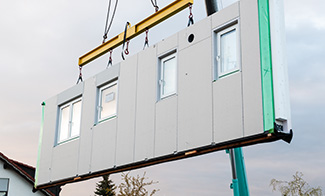Offsite Fabrication: The Changing Face of Construction
For many years when people spoke of modular construction, it was assumed they were talking about prefabricated houses. Today, however, modular or offsite construction techniques are reshaping projects of all types. This includes not just single-family residential projects but also commercial structures, roads and bridges, and public infrastructure projects.
The concept of using modular components fabricated elsewhere and assembled onsite has a long history in the construction industry. Pre-hung doors and preassembled windows have been used by homebuilders for generations, while tilt-up walls became commonplace in small commercial and retail projects years ago.
Also, restaurant, retail, and hospitality franchises have long used prefabricated components to control costs and provide consistency in appearance and performance.
So prefabricating entire rooms or major structural components is not really revolutionary. Rather, it represents an evolutionary change – the logical next step as the scale and scope of modular construction continues to expand.
Modular Construction Advantages
One recent example of how far modular construction has come is the use of prefabricated components to replace aging bridges and other infrastructure. The costs are not necessarily lower, but highway and heavy construction companies often can shorten the duration of road closures and reduce inconvenience to motorists. That feature has a strong appeal to the transportation officials who award contracts.
This illustrates one of the primary advantages of modular construction: It can help contractors accelerate project timelines. Instead of waiting for one trade to finish work before the next trade can start, modular construction allows various processes and subprocesses to be completed simultaneously, rather than sequentially.
The principle is the same as the “just-in-time” inventory techniques used in the auto industry and other manufacturing settings. The objective is for the various prefabricated components to arrive on-site just in time to link up with other systems.
When properly executed, offsite fabrication also offers the promise of better quality control since building systems and components are assembled under controlled conditions. This can help reduce weather-related delays and other complications while also enabling better safety controls.
Some modular proponents also point to prefabrication as a way to deal with the industry’s chronic labor shortage. Many construction employees find working in a controlled environment on a predictable schedule to be more appealing than working onsite in uncomfortable conditions.
Finding the Next Opportunities
Depending on the nature of your business and the markets you serve, it’s likely your company already engages in some level of offsite or modular construction. But more enterprising companies are going beyond the established modular techniques and looking instead for new ways to take advantage of their potential benefits.
Here are three points to keep in mind as you seek to expand your use of offsite prefabrication:
1. Create opportunities – Don’t wait for the perfect chance to use modular techniques. Best-in-class companies aren’t just willing to try new methods — they go out of their way to find excuses to use them.
2. Start early – Think modular from the outset of the project. Whenever possible, begin collaborating with the architecture and engineering teams to identify modular construction opportunities while the project is still in the planning stages. The continued growth of three-dimensional building information modeling (BIM) techniques and other design-build tools can further encourage this.
3. Collaborate – Work with manufacturers and other trades. Make connections with component manufacturers to think of new components to fabricate and better ways to combine them. Under the right circumstances, a joint venture (or even a less formal working arrangement) could pave the way for an important breakthrough.
Just as manufacturers work constantly to perfect their on-demand scheduling and just-in-time inventory practices, savvy contractors and subcontractors will continue to refine their offsite and modular construction capabilities. Being willing to experiment with new methods can help you stay ahead of the game — and give you a long-term competitive advantage.
